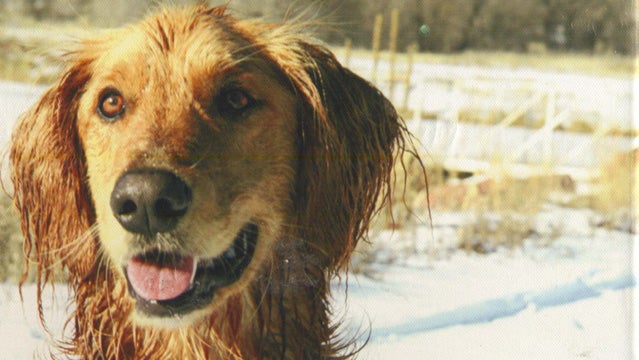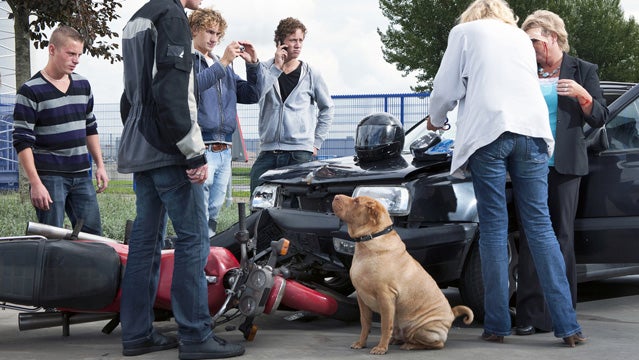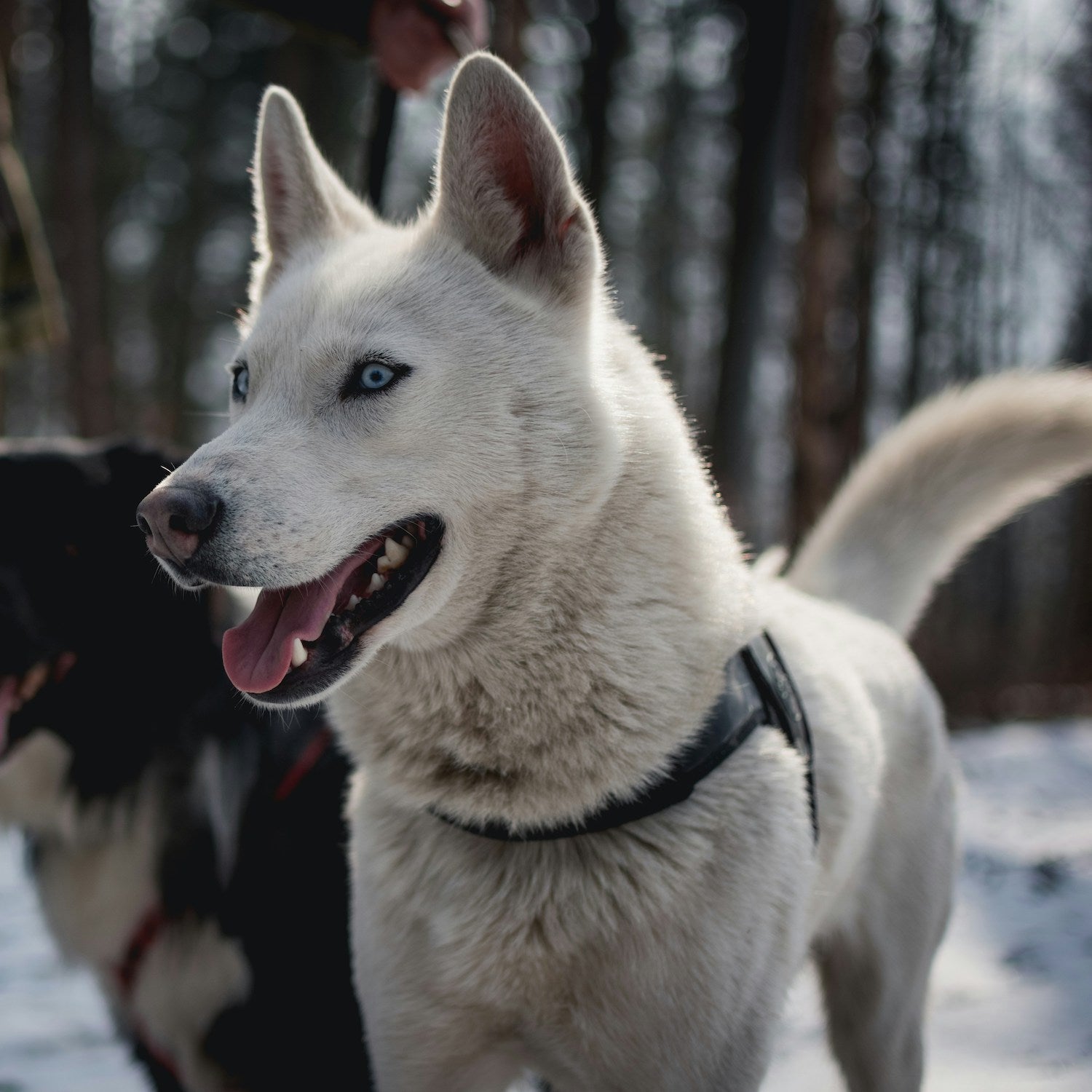There I was prone on the trail, the skin scraped from my knees and palms. I clutched my throbbing ankle between my hands. My dog, a loyal doberman I’d adopted from a shelter a few years before, poked my face with his nose. “I’m okay, buddy,” I said.
I stood, gently placing my sore foot on the ground. Pain shot up my leg. I was far from okay. I hadn’t brought my cell, and I was in the woods, on a desolate rocky trail, one or two miles from home. I began hopping on one foot, my dog slowly trotting by my side.
As I made forward progress, I looked at my dog and wondered: Could I train you to help me during a time like this? That led to other thoughts. Would he defend me against a wild animal? Or a human? Could he, if the need arose, save my life?
The answer to those questions, I’ve since learned, is this: Most definitely. And your trail dog could save you, too. Here are the real-life stories and training advice to prove it.
Dogs Lead Lost Humans Back Home
“Humans can get lost, but I knew I could trust the dogs. Dogs can direct themselves by sniffing out a scent.”

The Ultimate ���ϳԹ��� Companion
In early fall 2004 Angeline Longshore embarked on her first-ever backpacking excursion on what, according to weather forecasters, was supposed to be a weekend filled with blue skies and spring-like warmth. After two days of light hiking, she and her companion set up camp for their final night in the Sierras. They were near a picturesque lake. Visible in the distance were five other campers and a couple of frolicking dogs.
In late afternoon, Longshore noticed dark clouds. “It looks like we’re going to have some weather,” she said. They prepared for rain and got inside the tent. Soon it was dark. Then temperatures plummeted and snow began to fall.
“As soon as it started snowing, I knew it wasn’t good,” Longshore says. “We only had enough food for one more day—a candy bar, a package of miso soup, and some dried meat and fruit. It was freezing cold and we didn’t have the right clothes. I had to spoon with my friend to stay warm.”
By pre-dawn, the snow was already knee deep and still coming down. “It was a huge, huge dump. There was no trail at all,” she says.
Longshore scanned the area, searching for the other campers she’d seen the night before. They’d already hiked off, but their footprints and those of their dogs were still visible.
She and her companion began following the tracks. “Humans can get lost, but I knew I could trust the dogs. Dogs can direct themselves by sniffing out a scent,” she says.
Using the dog tracks as trail markers, Longshore and her friend hiked down as quickly as they could, occasionally saying, “We have to keep up. We’re losing the tracks” as the snow continued to fall.
She and her companion never caught up to the other hikers and their dogs, but six hours later the tracks led them to the trailhead.
“I was so relieved,” says Longshore. “It was definitely those dogs who saved us.”
How to Teach Your Dog to Track
Longshore’s hunch to follow the dog tracks was a good one. “A dog’s sense of smell is millions of times better than ours,” explains Mirkka Koivusalo, Ph.D., head trainer at Mindful Behaviors in Toronto who has trained dogs for search and rescue, tracking, and scent detection.
That said, tracking requires specialized training. “Some dogs will wander around aimlessly, just getting you even more lost,” says Val DeSantis, a dog behavioral consultant and trainer in Pueblo, Colorado.
Various schools and clubs around the country offer classes in tracking and nose work. One simple skill you can teach your dog at home: Find the car.
This not only comes in handy if you are lost on a trail, it will also help you to more quickly locate your car in large parking lots, says Anna Jane Grossman, owner of School for the Dogs in New York and editor of web magazine.
1. Start by rewarding your dog with extremely yummy treats every time you get into the car to go anywhere. This creates a positive association. Your dog sees your car and thinks, I like that car. “You want your dog to know that the car is a special place to be,” says Grossman.
2. Once your dog gets excited whenever you’re going to the car, add a command, such as “car” or “find car.”
3. Stand roughly 20 feet away from your car and say, “find car.” If your dog does it effortlessly, increase your distance.
4. Once your dog can reliably find the car on command, experiment with new locations. For instance, the next time you are at a park, in a parking lot, or on the trail, tell your dog to “find car” and see how he does.
Dog Fights Off Mountain Lion
“I should have reacted differently, but I first just noticed how beautiful it was.”

The Ultimate ���ϳԹ��� Companion
Cindy Kalyan and Betsy Burton were hiking with their dogs on a Colorado mountain trail when Burton noticed movement out of the corner of her eye. She turned to look and there stood a mountain lion, less than 10 feet away.
Burton had volunteered at a mountain lion rehab center in Telluride, so her first thought wasn’t typical. She knew mountain lions were shy, usually choosing to stay away from humans. She wasn’t alarmed.
“I should have reacted differently, but I first just noticed how beautiful it was,” she says. “Then it did exactly what you don’t want a mountain lion to do. Its ears were flat back and it crouched down.” That’s when Stanley, Kalyan’s golden retriever, jumped between Burton and the lion.
“I managed to rip a branch from a tree. It’s amazing what adrenaline allows you to do,” Burton says. “Cindy picked one up from the ground. We held them over our heads and we yelled, but the lion kept coming toward me.”
All the while, Maggie, Burton’s border collie mix, cowered behind her, while Stanley, the retriever, stood his ground, growling and barking. Burton slowly walked backward as the lion crept forward. Stanley lunged for the lion over and over, defending Burton. Then the lion stopped, turned, and retreated. Stanley pursued, chasing the lion up a nearby tree.
“Stanley was standing at the bottom of the tree, guarding the lion and making sure it wouldn’t come back down,” says Kalyan. The women walked away from the lion, calling Stanley to come. He didn’t. Eventually the two women could not see or hear the dog.
“We were crying, thinking that Stanley was dead. Then he came bounding over this hill with this expression on his face that seemed to say, Can you believe it? Can you believe it? It was amazing. Stanley was incredible,” says Burton.
How to Teach Your Dog to Defend
Some dogs will cower behind their owners whereas others will meet a threat head on. If you have a working dog with a tough temperament—such as a shepherd, Rottweiler, doberman, or terrier—you may be well protected against bears, mountain lions, and even human threats.
Even so, it takes many, many hours and a lot of expertise to properly train a guard dog. That’s why celebrities and millionaires hand over tens of thousands of dollars to dog trainers, who then work with their dogs for many months, says Val DeSantis, a dog behavioral consultant and trainer in Pueblo, Colorado.
One handy skill that you can teach your dog at home, however, is this: to bark on command. Your dog’s bark is probably louder than your yell, so it will draw attention to your plight and might be enough to scare off a wild animal. To start, reward your dog whenever he barks. Eventually your dog will bark and look at you, waiting for a treat. Now add a command, such as “speak” or “bark” at the moment your dog barks. Work up to saying the command, waiting for the bark, and then rewarding with a treat.
Dog Runs For Help
“I was a little dizzy and lightheaded, so I decided to walk for a few steps. Then I had to squat down and then, apparently, I passed out.”

The Ultimate ���ϳԹ��� Companion
It was early morning and Nancy Robinson was off for her usual trail run with her dogs, a shepherd mix named Marlo and a boxer named Spenser. About halfway through her run, she felt something sting her just above her right ear. She kept running, a dog on either side, but soon she felt off her game.
“I was a little dizzy and lightheaded, so I decided to walk for a few steps. Then I had to squat down and then, apparently, I passed out,” she says.
Robinson’s dogs sat beside her, with Spenser, the boxer, continually licking her face. She remained there, coming in and out of consciousness, for 45 minutes before a woman happened by a nearby trail. Robinson’s dogs ran to the woman, wildly barking and trying to get her attention, their leashes dragging behind them. At first the woman turned in a different direction, afraid of the dogs. Eventually, however, the woman noticed what she thought was a pile of clothes. As she stared, she realized that what she saw wasn’t clothes. It was a person.
Still afraid of the dogs, the woman got help from a park ranger who then called 911. Robinson was treated for anaphylactic shock and fully recovered. “There are people who think dogs are just pets, but they are so much more than that. They are amazing,” she says.
How to Teach Your Dog to Get Help
The good news is that training your adventure dog to get help is simpler than you’d think. You’ll just need the help of a second person to pull it off.
1. While you and another adult are in the same room, reward your dog every time he or she glances at the other person. For instance, your reward might be an enthusiastic “yes!” or a click from a clicker along with a tiny bit of a very tasty treat. At first, you might have to wait quite a while before your dog happens to glance over. Eventually, however, your dog will catch on, says Anna Jane Grossman, owner of School for the Dogs in New York and editor of TheDo.gs Web magazine.
2. Slowly ramp up the challenge, waiting for your dog, for instance, to physically walk over to the other person. Reward your dog both for walking to the other person and also for returning to you.
3. Add a command such as “go find,” and increase the challenge by standing farther and farther apart. You want to get to the point that one person can hide in another room. Try playing this game of hide and seek in many different surroundings: indoors, outdoors, at parks, and on the trail.
Here’s the downside: You can’t ever be sure that another human will be able to interpret your dog’s barks as “Please help my owner! Please follow me!” As a result, Mirkka Koivusalo, Ph.D., head trainer at Mindful Behaviors in Toronto, suggests you create a handwritten note that you can attach to your dog’s collar and take with you whenever you are in the wilderness. Write it on a bright piece of fabric, saying something like: “My owner is in trouble. Follow me.” You might also bring a permanent marker with you, so you can add details of your location, if needed.


